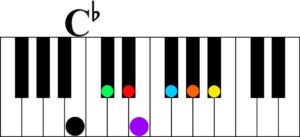

Try to read this post again, and see if you got it : can you connect the keys to their key signatures ? (we will see later that the same key signature can be used to a minor key)
MUSIC KEYS IN ORDER PLUS
Add a semitone to the last sharp : D♯ plus a semitone is E. Take the last sharp of the key signature, add a semitone : here is the major key corresponding to the key signature.įor example, if you have a key signature with 4 sharps ( F♯- C♯- G♯- D♯). If you know the key signature, and want to know the key : You can now write the sharps (in A major, it would be 3 ♯) using the right order. The list of sharps is : F♯- C♯- G♯- D♯- A♯- E♯- B♯ It starts with F♯, and then goes up a perfect fifth, so you get to C♯, and then up a perfect fifth, so you get to G♯, and so on. The second thing to know, is the order of the sharps. (If you know the A major scale, you know that it's spelled a-b-c♯-d-e-f♯-g♯-a. The first thing to know, is your major scales.
MUSIC KEYS IN ORDER HOW TO
How to memorise this list ? If you know the key, and want to write the key signature : The smallest space or interval between each musical note is called a half-step, and keys are groups of notes separated by specific intervals. As you can see, once the Key-signature is written, there is no need to write the ♯ again. Then I wrote a new key signature ( C♯ major : 7 ♯) and again, the C♯ major scale.

In the following score, I wrote a C♯ major scale with no Key-signature in the first 2 bars. Then I wrote a new key signature ( F♯ major : 6 ♯) and again, the F♯ major scale. In the following score, I wrote a F♯ major scale with no Key-signature in the first 2 bars.

Then I wrote a new key signature ( B major : 5 ♯) and again, the B major scale. In the following score, I wrote a B major scale with no Key-signature in the first 2 bars. As you can see, once the Key-signature is written, there is no need to write the ♯ again. HALF AND WHOLE STEPS: half-step - two keys (and therefore notes/pitches) that are adjacent on the piano keyboard. Then I wrote a new key signature ( E major : 4 ♯) and again, the E major scale. In the following score, I wrote a E major scale with no Key-signature in the first 2 bars. Then I wrote a new key signature ( A major : 3 ♯) and again, the A major scale. In the following score, I wrote a * A major scale with no Key-signature in the first 2 bars. Then I wrote a new key signature ( D major : 2 ♯) and again, the D major scale. The song will have a particular 'D' sound to it. So what does that mean If we play a song in the 'key' of D, then that whole song will be based around a D note, or a D chord. In the following score, I wrote a D major scale with no Key-signature in the first 2 bars. Music is generally played in a particular tonality or key. Then I wrote a new key signature ( G major : 1 ♯) and again, the G major scale. In the following score, I wrote a G major scale with no Key-signature in the first 2 bars. List of the major key signature using ♯ The key of G major You can check this post and this other post if you want to be comfortable with major scales. 1st Tonic- key note 2nd Supertonic 3rd Mediant 4th Subdominant 5th Dominant 6th Submediant 7th Leading tone 8th Tonic ( or Octave) Key Signatures. That is :Īnd then discuss the technique to memorise those key signatures In this post I will list the key signatures corresponding to major keys using sharps.



 0 kommentar(er)
0 kommentar(er)
